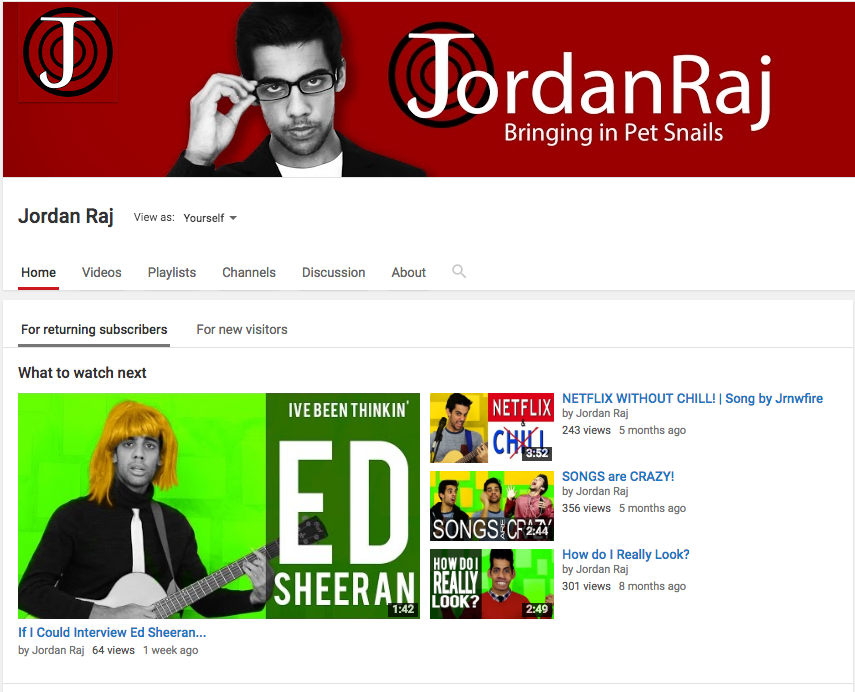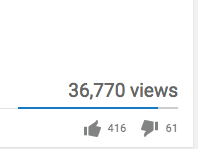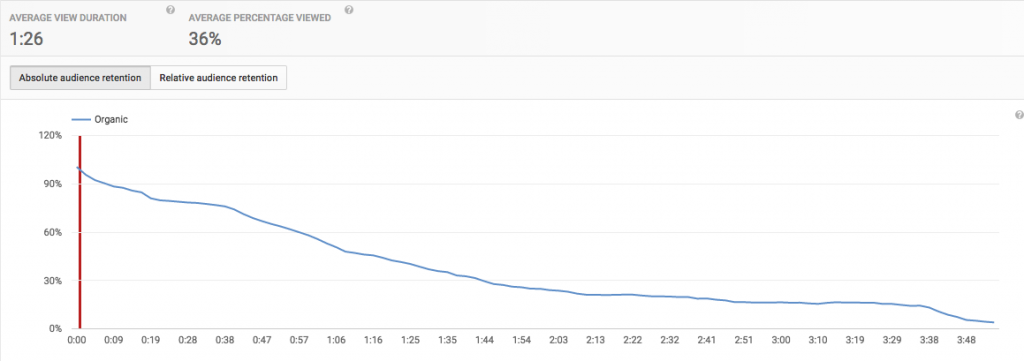Over the past seven years I have been uploading videos to a youtube channel known as ‘Jordan Raj’ (formerly Jrnwfire). Throughout this time I have uploaded around 130 videos, with all sorts of random content and genres. This has been a sort of journ ey, not only of self discovery but also an endeavour to understand and taylor content to a specific audience. The following exploration aims to outline the learnings I have obtained but also reflect on the future of Jordan Raj and where I can take it from here.
ey, not only of self discovery but also an endeavour to understand and taylor content to a specific audience. The following exploration aims to outline the learnings I have obtained but also reflect on the future of Jordan Raj and where I can take it from here.
Firstly, I would like to outline the limitations of my exploration. I will only be looking at my particular audience, this is because I have very detailed statistics specifically on my own audience. Furthermore, I am making assumptions based on very sporadic and inconsistent content, which is only really characteristic of my own individual case. However, in order to validate my claims i will be looking at the information gathered in the context of further research, such as what makes a video viral and what makes an audience engage.
Now that I have established what my limitations are, its time to begin, who is my audience. The best way to answer this question is to look at my youtube analytics:
Here i’m choosing to look at the statistics for the lifetime of my channel, therefore im capturing the most general overview of the audience. From simply looking at this basic statistic it it is blaringly evident that the majority of my audience is male. This alone however is not enough information, luckily youtube offers me more:
From this further information we can identify my audience as mainly male and located in the United States. However, there is a very important piece of information which needs to be considered; 41% of my views have come from a single video.
The video titled “How to Money from Vending Machines” has received 140,000 views, and has mainly been found through the “Youtube Search” or “Direct sources”. This video is intended to be a light parody of our vending machine habits, however it is evident from some of the statistics that this is NOT what the audience expected from the title. It has quite a low audience retention and an overwhelming number of dislikes:
It is quite clear that in this case I have attracted the wrong auience. Regardless, I have gained a valuable insight; title is important. This is an assumption which further proves to be true when we look at the second most viewed video, “BEST PUNS EVER – Vine Compilation”. This video is responsible for 16% of all my channel views and has arguably the best title, it is accurate to name and entices a click from the audience. Unlike the previous video it actually has a significantly higher retention rate and much more positive feedback:
 This video would have to be my most successful video, simply because the intent aligned with the results. Yes, I have other videos that people have found interesting, but this one seems to stand alone in terms of original intent to success ratio. By this I mean the video was made as a comedy, and the positive feedback suggests that is getting viewed by people who want to enjoy it as a comedy. Thus at this point I would like to discuss what makes a video go viral and what makes it popular, I’m looking at any possible correlation between the success of the puns video and the results from the following study:
This video would have to be my most successful video, simply because the intent aligned with the results. Yes, I have other videos that people have found interesting, but this one seems to stand alone in terms of original intent to success ratio. By this I mean the video was made as a comedy, and the positive feedback suggests that is getting viewed by people who want to enjoy it as a comedy. Thus at this point I would like to discuss what makes a video go viral and what makes it popular, I’m looking at any possible correlation between the success of the puns video and the results from the following study:
Guadagno, Rosanna E. et al. ‘What Makes A Video Go Viral? An Analysis Of Emotional Contagion And Internet Memes’. Computers in Human Behavior 29.6 (2013): 2312-2319. Web.
The above is a published study that aimed to mathematically analyze the factors which determine a videos ‘shareability’ or what causes a video to go viral. The central hypothesis suggested that the video would be shared more if it created an emotional impact on the audience. Within the scope of emotional impact it also suggested that a video conveying positive emotions was more likely to be shared than one conveying anger or disgust. In order to conduct this study a number of videos were selected and then showed to a sample of undergraduate students. The students were then to give a quantitative answer on how likely they were to share the video. Not surprisingly the hypothesis was in fact proven, people tended to share videos that had a positive emotional response.
This hypothesis does agree with the idea that a comedy video would receive a positive response, however it does not directly address the idea of audience retention or engagement. Regardless i feel it is safe to assume that if a video is creating a positive emotional response people would be more likely to maintain interaction. Likewise, if their expectations, which they may have gained from the title, are being fulfilled they would not feel cheated and click out.
It is also worth noting that the audience for the study were undergraduate students, lets reffer to the audience age of the puns video:
Unsurprisingly the majority of the audience is university age, between 18-24. This is also the age of the students being surveyed for the above study, allowing our assumptions to be more accurate. Certainly the emotional response is one very important factor in what makes a video have high response rate. However the actual personality and mindset of the viewer needs to be considered; their personal susceptibility etc.. Additionally conducting a study and presenting viewers with media is very different to the way that they would otherwise organically receive it. Overall, the idea that emotional connection with a video directly links to its shareability was a very valid and worthwhile investigation, however in order for this research to be applied there needs to be consideration of many different factors. For example, the expectation and means by which they are recieving content.
One way in which the youtube audience in specific responds to this phenomena is by creating subscribers. Subscribers are those that commit to receiving your content when you release more and are constantly kept up to date with your news. By employing this system one ensurees that the audience that they are delivering to has an expectation, based on previous content and familiarlity with a channels personality and style. Over time this has a two-fold effect; the audience becomes more loyal and consistent, with a relationship being formed, and secondly, the content creator starts to curate for the expected audience. The following study on predicting audience gender speaks to this idea:
Predicting audience gender in online content-sharing social networks
Xiao, Chunjing ; Zhou, Fan ; Xiao, Chunjing ; Zhou, Fan ; Wu, Yue
Journal of the American Society for Information Science and Technology, June 2013, Vol.64(6), pp.1284-1297
The above article focused on a study that aimed to measure the accuracy of different prediction methods to determine the gender of an audience. The method involved comparing early audience and late audience as well as the trend of gender for a particular media content creator. It was found that the more content a creator had produced the more accurately gender could be predicted. The main use of this study would be to optimize searches and advertising. However, it is useful in the sense that it can provide content creators with confirmation that the gender of their fan base will maintain consistency as long as they deliver the same type of content.
In my particular case i find this intriguing because of my drastically skewed male audience. Im aware that my audience is 70% male and mostly between the ages of 18-24, therefore if I want my content to be more shared and appealing it only makes sense that I should start curating it to this audience. But, what if i dont WANT this to be my primary audience. What if I want to establish a male-female 50-50 split, and i want to deliver content that is appealing to both genders. It would be necessary in this case for me to embrace other elements of content curation, elements which regard consistency and expectation as important while at the same time trying to redefine my audience. The following essay discussing the work of Chis Lilley on youtube raises some interesting points:
Erhart, J. (2014). ‘Mr G is deffinately bringin’ Sexy back’: characterizing Chris Lilley’s YouTube audience. Continuum, 28(2), pp.176-187.
This essay looks at the impact of Chis Lilleys Youtube audience and how having content on both TV and the internet affect his audience response. It looks at numerous user comments and discusses how expectation and loyalty is being built up in the fan base. However i found the following quite interesting:
“Let me look closely at the example of the upload ‘Ja’mie Bloopers Summer Heights High’. The title of the YouTube is self-explanatory. The frequent motif that comes up in posts attached to this upload – as elsewhere on YouTube and indeed throughout critical responses to Lilley – concerns his acting prowess”
This brief excerpt from the study confirms what I have deduced up until this point; titling is very important. Throughout the study it’s clear that the audience always knows what to expect and they associate some familiarity with the titles and expect to see a particular type of content. The audience is drawn in by a reason to click and a desire to investigate the topic further. The key idea here is that expectation is transformed into delivery.
Therefore what I believe is that expectation is always going to be the key to creating audience retention. Expectation must always inform the entertainer and allow for them to curate the content, responding to the subliminal vulnerabilities and requisitions of the audience. This is even an idea which is explained at length by entertainers and writers such as Gene Perret, Bob Hope and Judy Carter, all of whom are expert comedians and writers. They understand that entertainment is essentially the process of allowing an audience to realize and experience what they truly desire.
In conclusion, the YouTube audience is not unlike any other audience. Their expectations must be met by the entertainer in order to receive positive response. Thus in order to reach them, a content creator, which in this case is me, must continue to deliver consistent content that establishes clear expectation and eventually delivers upon it. Over time this will create a fan-base which will continue to return and further build up expectation which will lead to my further curation and tailoring of content. This cycle is essential to any audience, and is what leads to success.
Sources:
Alphabet Inc. (2016). Youtube Analytics. Youtube.
Carter, J. (2001). The comedy bible. New York: Fireside.
Perret, G. (2007). The new comedy writing step by step. Sanger, CA: Quill Driver Books/Word Dancer Press.
Guadagno, Rosanna E. et al. ‘What Makes A Video Go Viral? An Analysis Of Emotional Contagion And Internet Memes’. Computers in Human Behavior 29.6 (2013): 2312-2319. Web.
Predicting audience gender in online content-sharing social networks
Xiao, Chunjing ; Zhou, Fan ; Xiao, Chunjing ; Zhou, Fan ; Wu, Yue
Journal of the American Society for Information Science and Technology, June 2013, Vol.64(6), pp.1284-1297
Erhart, J. (2014). ‘Mr G is deffinately bringin’ Sexy back’: characterizing Chris Lilley’s YouTube audience. Continuum, 28(2), pp.176-187.







Leave a Reply